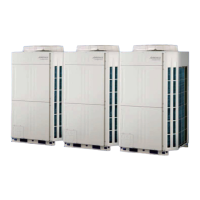
Do you have a question about the Fujitsu Airstage VR-II ARUM24TLAV and is the answer not in the manual?
| Brand | Fujitsu |
|---|---|
| Model | Airstage VR-II ARUM24TLAV |
| Category | Air Conditioner |
| Language | English |
Lists essential checks to perform before powering on the system.
Details the inspection process for the power source, including breaker size and wire size.
Covers inspection of refrigerant piping, including insulation, filter, oil trap, pipe length, and height difference.
Continues piping inspection, focusing on branch port piping layout for RB units and RB series connection.
Details how to inspect the refrigerant charge amount for outdoor units and connecting pipes.
Covers checks to be performed after the system has been powered on.
Inspects actual power supply voltage to outdoor and indoor units.
Details operation checks for cooling and heating modes, monitoring various parameters like pressure, temperature, and superheat.
Covers procedures for conducting test runs on the installed VRF system.
Explains how to perform a test run using the outdoor unit's push button settings.
Details test run procedures using standard wired, wireless, and simple remote controllers.
Explains how test run signals are transmitted and how operation modes are controlled during testing.
Provides detailed refrigerant circuit diagrams for outdoor air units (AAUA48/96TLAV and AAUA72TLAV).
Details compressor operation, including start/stop conditions and special operations.
Defines the conditions under which the compressor operates or stops, including protective measures.
Describes compressor speed control based on operating range, outdoor temperature, and cold start conditions.
Explains capacity control of the compressor, including operating range and target pressure control.
Details the starting and stopping sequences for compressors based on various operating conditions.
Describes the control of electronic expansion valves (EEVs) for refrigerant flow regulation.
Details the conditions and procedures for defrost operation to prevent icing of the indoor heat exchanger.
Lists and explains various protective functions to safeguard the system components.
Details discharge temperature protection mechanisms, including starting and release conditions.
Explains high pressure protection functions, including start and release conditions for various patterns.
Details low pressure protection, including start conditions, release conditions, and abnormal operation.
Details compressor temperature protection, covering start conditions and release criteria for preventing damage.
Explains overcurrent protection for the inverter PCB, including start and release conditions.
Details fan control for indoor units, including speed settings and automatic operation.
Explains how to set the fan speed for indoor units using the control button.
Covers master control functions, including mode settings for different connectable types.
Details operation mode control for Cool, Dry, and Heat modes, including stop mode and drain pump control.
Explains the initialization, operation control, and special control of electronic expansion valves.
Describes EEV control for outdoor air units in cooling and heating operations based on airflow temperature.
Covers abnormal operation and how error codes are displayed, including subsection and specifics.
Explains the 3-digit error code format and how to confirm actual error conditions using service tools.
Shows how error codes are displayed on simple, wired (3-wire, 2-wire), and group remote controllers.
Provides a cross-reference of error codes displayed on various units and controllers to specific error contents.
Continues the error code list, covering additional errors and their specific contents.
Classifies system conditions based on outdoor unit errors and their impact on indoor units and service tools.
Provides detailed troubleshooting steps for specific error codes, including detective actuators and causes.
Provides a systematic approach to troubleshooting issues when no specific error code is displayed.
Details troubleshooting steps for RB units that are not receiving power.
Guides troubleshooting when the unit has power but does not operate, checking installation and electrical components.
Provides steps to diagnose and resolve issues related to the absence of cooling or heating.
Details troubleshooting steps for water leaks from indoor units, including checking drain systems and EEV.
Provides a systematic approach to diagnose and resolve 'No Power' issues on the outdoor air unit.
Offers basic troubleshooting steps for network communication abnormalities, including error code checks and service tool usage.
Explains how to respond to refrigerant deficiency, including reusing or recharging refrigerant after compressor work.
Details the process of charging refrigerant after compressor replacement, including vacuuming and amount adjustment.
Guides diagnosis for compressor issues like no start, stops after starting, or abnormal noise, and replacement.
Details service procedures for the inverter compressor, including connection checks and winding resistance tests.
Covers checks and replacement procedures for the Main PCB and Filter PCB (Main).
Details service procedures for the Filter PCB (Main), including fuse checks and wiring connections.
Provides steps for checking and replacing the Inverter PCB, including electrical parts checks.
Details service procedures for the Filter PCB (INV), focusing on resistance measurements.
Explains checks for the IPM module on the Inverter PCB, including resistance and voltage measurements.
Covers checks for indoor unit EEVs, including connections, coil resistance, voltage, noise, and operation.
Details checks for outdoor unit EEV1, including connections, coil, noise, voltage, and operation.
Provides checks for outdoor unit EEV2, including connections, coil, noise, voltage, and operation.
Details checks for outdoor unit EEV3, including connections, coil, noise, voltage, and operation.
Explains how to check the voltage of the discharge pressure sensor on the Main PCB.
Details how to check the voltage of the suction pressure sensor on the Main PCB.
Provides a table for checking thermistor resistance values against temperature for various sensors.
Illustrates the refrigerant circuit diagram for various outdoor unit models (AOUA72/96/120TLBV).
Provides detailed precautions and procedures for removing the compressor, including power off and refrigerant collection.











